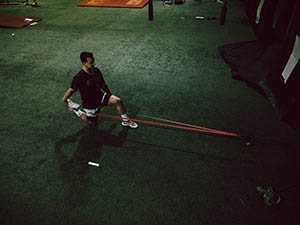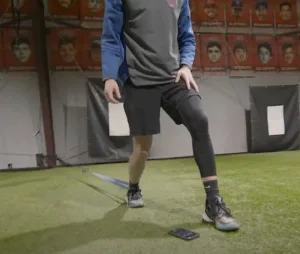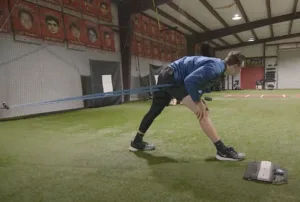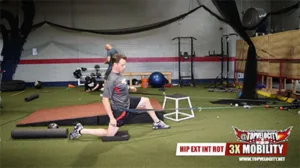 Are you searching for the answers to the question, Does stretching increase pitching velocity? Then this article has done all the research for you and more!
Are you searching for the answers to the question, Does stretching increase pitching velocity? Then this article has done all the research for you and more!
In the world of baseball, pitching velocity can be a game-changer, separating the good from the great. As players strive to maximize their performance on the mound, the role of stretching in enhancing pitching velocity has come under scrutiny. This comprehensive guide delves deeper into the science behind stretching and its potential impact on pitching velocity, providing valuable insights for players and coaches alike.
Unveiling the Science Behind Stretching and Pitching Velocity
Understanding the Mechanics: Does stretching increase pitching velocity?
Before diving into the research, it's essential to grasp the biomechanics of pitching. A successful pitch requires a coordinated sequence of movements involving multiple muscle groups, joints, and connective tissues. Stretching is often touted as a means to improve flexibility and range of motion, thereby optimizing the pitching motion. However, the extent to which stretching directly influences pitching velocity remains a subject of debate among researchers and practitioners.
Examining the Research: Does stretching increase pitching velocity?
Numerous studies have sought to elucidate the relationship between stretching and pitching velocity. One such study by Delobel et al. (2013) investigated the acute effects of upper extremity stretching on throwing velocity in untrained baseball throwers. The results indicated that neither static stretching nor proprioceptive neuromuscular facilitation (PNF) protocols focusing on increasing external rotation (ER) had a significant effect on throwing velocity. These findings suggest that factors beyond mere flexibility may play a more prominent role in determining pitching velocity.
Debunking Common Myths: Does stretching increase pitching velocity?
Contrary to popular belief, research by Haag et al. (2010) suggests that static stretching of the throwing shoulder may not significantly improve pitching performance. Their study, which examined the effects of acute static stretching on pitching performance in NCAA Division III baseball players, found no significant differences in velocity or accuracy measures between stretching and non-stretching conditions. These findings challenge the traditional notion that stretching alone can enhance pitching velocity and underscore the need for a more nuanced approach to performance enhancement.
 Exploring the Nuances of Pre-Game Routines
Exploring the Nuances of Pre-Game Routines
Beyond Stretching: A Holistic Approach
While stretching is often an integral part of pre-game warm-up routines, its efficacy in isolation may be limited. Pitchers should adopt a comprehensive approach that addresses various facets of performance enhancement, including strength training, mobility exercises, and skill development. By incorporating a diverse range of training modalities, players can optimize their overall performance on the mound and minimize the risk of injury.
The Importance of Individualization
It's important to recognize that not all athletes will respond to stretching in the same manner. Factors such as age, training history, and biomechanical characteristics can influence the effectiveness of stretching interventions. Coaches and players should work together to tailor pre-game routines to the specific needs and abilities of each individual, ensuring that stretching protocols are optimized for maximum benefit.
Integrating Research into Practice
While scientific research provides valuable insights into the efficacy of stretching for enhancing pitching velocity, its translation into real-world practice requires careful consideration. Coaches and practitioners should critically evaluate the available evidence and integrate evidence-based practices into their training programs. By staying abreast of the latest research findings, coaches can optimize their training methodologies and empower athletes to reach their full potential on the field.
 Exploring the Benefits of Stretching for All Athletes: Insights from a Comprehensive Review
Exploring the Benefits of Stretching for All Athletes: Insights from a Comprehensive Review
Stretching has long been regarded as a fundamental component of athletic preparation, aiming to improve flexibility, prevent injury, and optimize performance. However, despite its widespread adoption, there remains a lack of comprehensive understanding regarding the efficacy and nuances of stretching interventions, particularly in the context of healthy athletes. A recent scoping review conducted by Afonso et al. (2024) sheds light on the current state of stretching research, highlighting key gaps and priorities for future investigation.
Key Findings from the Scoping Review
The scoping review encompassed 300 trials involving over 7,000 healthy athletes across various sports disciplines. Notably, the majority of participants were male, with limited representation of female athletes. The review revealed a predominant focus on acute stretching effects, with chronic interventions receiving less attention. Furthermore, while static active and dynamic stretching were the most commonly studied modalities, other approaches such as proprioceptive neuromuscular facilitation (PNF) stretching were relatively underexplored. Most trials implemented stretching within warm-up routines, with less emphasis on post-exercise application. Additionally, there was heterogeneity in dosage reporting and a lack of consistency in outcome measures, with a notable dearth of research on biomechanical, physiological, and injury-related outcomes.
Implications for Athletes
Despite the gaps identified in stretching research, several insights emerge that can inform athletes' training practices:
- Flexibility Enhancement: Stretching, particularly dynamic and PNF modalities, may contribute to improved flexibility, thereby enhancing athletes' ability to perform a wide range of movements with greater ease and efficiency.
- Injury Prevention: While the direct link between stretching and injury prevention remains inconclusive, incorporating stretching into pre- and post-exercise routines may help mitigate the risk of musculoskeletal injuries by promoting tissue elasticity and range of motion.
- Performance Optimization: Although the impact of stretching on performance outcomes varies across studies, maintaining optimal flexibility through regular stretching may indirectly contribute to enhanced athletic performance by facilitating proper movement mechanics and reducing the likelihood of overuse injuries.
Recommendations for Future Research
The scoping review underscores the need for targeted research efforts to address the following gaps and limitations:
- Dose-Response Relationships: Further investigation is warranted to elucidate the optimal dosage and timing of stretching interventions for maximizing benefits while minimizing potential adverse effects.
- Underrepresented Populations: Research should strive to include diverse athlete populations, including elite-level athletes and individuals participating in sports with extreme ranges of motion, to ensure the generalizability of findings.
- Long-Term Effects: Chronic effects of stretching interventions, including their sustained impact on performance and injury prevention, warrant greater attention through longitudinal studies with extended follow-up periods.
- Comprehensive Outcome Assessment: Future studies should adopt standardized protocols for assessing a wide range of outcomes, including biomechanical, physiological, and injury-related parameters, to facilitate meaningful comparisons and evidence synthesis.
While the scoping review by Afonso et al. (2024) highlights several gaps and challenges in the current landscape of stretching research, it also underscores the potential benefits of incorporating stretching into athletes' training regimens. By addressing these research gaps and advancing our understanding of stretching's role in athletic performance and injury prevention, we can better optimize training protocols and support the holistic development of athletes across all levels and disciplines.
 Explore the TopVelocity Mobility Program
Explore the TopVelocity Mobility Program
Are you aspiring to become a high-velocity pitcher but lack the genetic joint mobility profile typically associated with elite pitchers? Look no further than the 3X Mobility Training offered by TopVelocity's Mobility Program.
- Unlocking High Velocity Potential: High-velocity pitchers leverage elite joint mobility to harness their entire body's kinetic chain, generating 90+mph pitching velocity. While genetics play a role, the TopVelocity Mobility Program introduces a scientific approach to unlock and develop these essential joint ranges.
- Comprehensive Joint Range Assessment: The program begins with a thorough assessment of key joint ranges, including dorsiflexion, plantar flexion, hip rotation and flexion, trunk mobility, and shoulder mobility. By comparing these ranges to those of high-velocity pitchers, you gain insights into areas for improvement.
- Tailored Exercise Regimen: Armed with this assessment, you'll embark on a tailored exercise regimen designed to enhance joint mobility. From foam rolling and static stretching to muscle activation techniques and banded distractions, each exercise targets specific joint ranges for improvement.
- Iterative Progress Tracking: As you commit to the program, you'll track your progress through regular joint range measurements. By identifying areas of improvement and adjusting your training focus accordingly, you'll steadily develop the joint ranges essential for high-velocity pitching.
Start Your Journey Today
Gain a competitive edge in the game by starting the 3X Pitching Mobility Course today. With TopVelocity's proven methodology and comprehensive approach, you'll be well on your way to unlocking your full pitching potential.
Ready to elevate your game? Visit topvelocity.net/mob and begin your journey towards pitching excellence now!
FAQs: Does stretching increase pitching velocity?
- Is stretching essential for improving pitching velocity? Stretching alone may not suffice to enhance pitching velocity significantly, as demonstrated by research studies.
- What other factors influence pitching velocity? Factors such as strength training, proper mechanics, and skill development play pivotal roles in maximizing pitching velocity.
- Are there any risks associated with excessive stretching? Overstretching or improper stretching techniques can potentially lead to injury or diminished performance.
- Can stretching improve overall performance on the baseball field? While stretching may contribute to overall flexibility and injury prevention, its direct correlation with enhanced performance requires further investigation.
Conclusion: Does stretching increase pitching velocity?
In conclusion, the relationship between stretching and pitching velocity is complex and multifaceted. While stretching remains a popular component of pre-game warm-up routines, its direct impact on pitching velocity may be less pronounced than previously believed. To optimize performance on the mound, players and coaches should adopt a holistic approach that integrates stretching with other training modalities and individualizes pre-game routines based on the unique needs of each athlete. By staying informed about the latest research findings and applying evidence-based practices, players can maximize their potential and elevate their game to new heights.
Does Stretching Increase Pitching Velocity? While stretching may offer benefits beyond velocity enhancement, its direct impact on pitching velocity may be more nuanced than previously assumed.
For more exclusive content visit the TopVelocity Patreon!


 Exploring the Nuances of Pre-Game Routines
Exploring the Nuances of Pre-Game Routines Exploring the Benefits of Stretching for All Athletes: Insights from a Comprehensive Review
Exploring the Benefits of Stretching for All Athletes: Insights from a Comprehensive Review Explore the TopVelocity Mobility Program
Explore the TopVelocity Mobility Program
